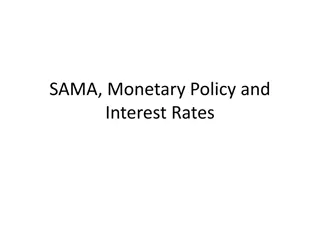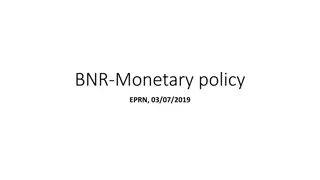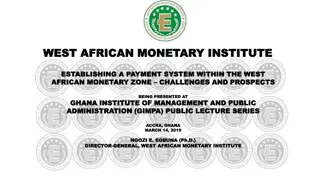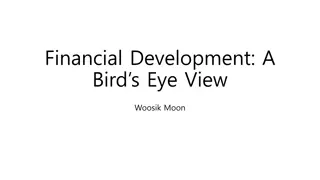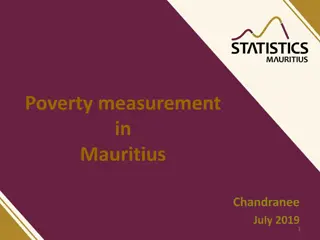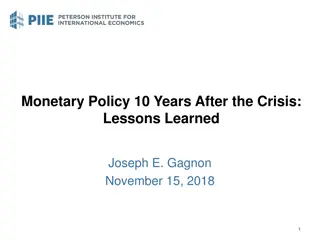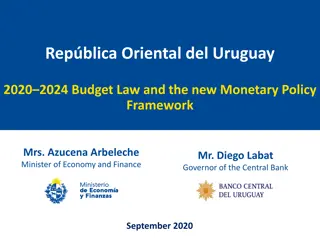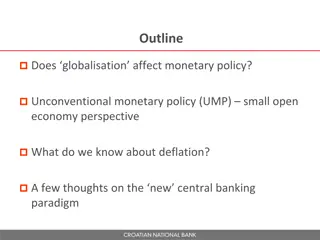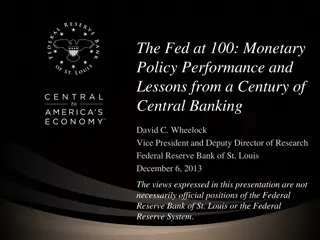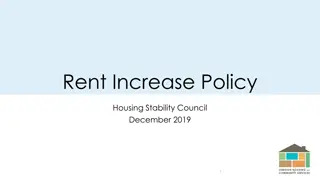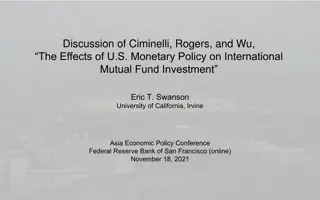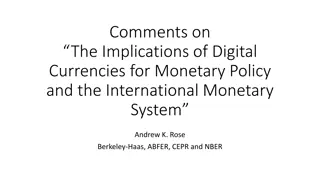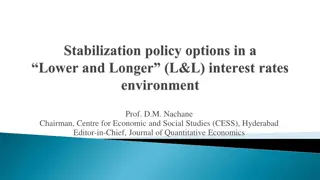August 2020 Monetary Policy Report & Financial Stability Report Highlights
In the August 2020 Monetary Policy Report & Financial Stability Report, key officials like Andrew Bailey, Ben Broadbent, and others discuss the economic projections, conditioning assumptions, and near-term forecasts. The report outlines the uncertainties caused by the pandemic and Brexit, highlighting factors such as demand changes, inflation, GDP, and unemployment. The session includes introductions, overviews of reports, and a Q&A with the officials.
Download Presentation

Please find below an Image/Link to download the presentation.
The content on the website is provided AS IS for your information and personal use only. It may not be sold, licensed, or shared on other websites without obtaining consent from the author.If you encounter any issues during the download, it is possible that the publisher has removed the file from their server.
You are allowed to download the files provided on this website for personal or commercial use, subject to the condition that they are used lawfully. All files are the property of their respective owners.
The content on the website is provided AS IS for your information and personal use only. It may not be sold, licensed, or shared on other websites without obtaining consent from the author.
E N D
Presentation Transcript
August 2020 Monetary Policy Report & Financial Stability Report Andrew Bailey Ben Broadbent Becky Maule Alex Brazier Dave Ramsden Friday 7 August 2020
Plan for the session Andrew will introduce the event Ben will give you an overview of the Monetary Policy Report Alex will give you an overview of the Financial Stability Report Q&A session with Andrew, Ben, Dave and Alex Please submit questions as we go and we ll put some to them anonymously We re also running a couple of polls to get your input on the economic outlook please do take part if you feel comfortable
Poll Question 1 How do you expect demand to change from current levels over the next twelve months? Options are: Rise strongly, rise modestly, remain unchanged, reduce slightly, reduce sharply (defined as >10% higher, 1-10% higher, unchanged, 1-10% lower, >10% lower)
AUGUST 2020 Monetary Policy Report Ben Broadbent Friday 7 August 2020
Conditioning assumptions Back to doing a forecast (albeit a very uncertain one). Direct impact of COVID-19 on economy assumed to fade away gradually over forecast. Encouraging signs of a return of activity post full national lockdown But MPC hasn t taken much signal from this about medium term Great deal of uncertainty (our fan charts are much wider than usual). Key risks involve the pandemic: how it evolves, the reaction of households, businesses and governments to the economic and health risks; the prospects for improving medical technologies. Orderly Brexit. 5
Projections CPI GDP Unemployment 6
Near-term: output Retail sales CHAPS spending DMP investment
Near-term: labour market Change in number of employees Employment intentions Total claims under government schemes
Near-term: inflation Contributions to CPI inflation Sales & spare capacity Unit costs
Medium term: consumer spending Estimated share of restricted weekly consumption Confidence around social consumption Household savings by income group
Medium term: labour market Firms uncertainty surrounding Coronavirus Furlough & output
Projections CPI GDP Unemployment 12
MPC perspective and policy MPR includes a box on issues involved in a negative Bank Rate. Effects may depend on nature and state of financial system. Given the uncertainties involved, MPC has said it will base policy on economy as it evolves, more than on medium-term forecasts at any particular point, and that it will not withdraw accommodation until confident of a significant degree of progress to its objectives. 13
Poll Question 2 How do you expect the size of your workforce to change over the next twelve months compared to pre-COVID levels? Options are: Rise strongly, rise modestly, remain unchanged, reduce slightly, reduce sharply (defined as >10% higher, 1-10% higher, unchanged, 1-10% lower, >10% lower)
Insert document classification (edit via 'Header & Footer') Update signpost August 2020 FSR Alex Brazier Friday 7 August 2020 Agency contacts briefing
Severe economic disruption resulting in cash-flow deficits for many companies Company Cash-flow deficits could sum up to 200bn GDP projection in the Monetary Policy Report Under the MPR central projection, companies could face a cash-flow deficit of up to around 200bn.
Supported by government-backed loan guarantee schemes, the financial system has met the initial surge in credit demand Finance raised by businesses in the period March-June
Banks are more than 3x stronger than in 2008 Banks loss absorbing capital (as % of assets)
How bad does the economy need to be to jeopardise bank lending? Banks loss absorbing capital (as % of assets)
How bad does the economy need to be to jeopardise bank lending? Banks loss absorbing capital (as % of assets) Equivalent to 120bn of credit losses
A: Twice as bad as the central outlook. UK real GDP needed to jeopardise bank lending Unemployment needed to jeopardise bank lending
Leading us to conclude Banks have got the buffers of capital to take the losses even in a very bad scenario. Cutting back lending isn t necessary to protect them. With businesses needing finance to bridge, cutting lending would be very costly for economy. (And hence also for the banks) So despite the wide range of uncertainty, banks can keep lending.
Bond and equity markets Finance raised by businesses in the period March-June
A need for more equity finance in the recovery Non-listed companies may benefit from greater access to equity finance: As finance for already highly levered companies To help repair balance sheets To support new entrants and growth of incumbents The FPC will examine distortions to supply of illiquid long term/equity-like investments and any regulatory obstacles
Important: dealing with contracts that use the LIBOR benchmark Lots of financial products still use the LIBOR benchmark interest rate. But that rate isn t based on very many actual transactions. It isn t robust. 2022 It could suddenly cease to exist after end 2021. Most larger borrowers will be affected in some way. You could be exposed to a sudden change in the terms of a contract. It s best to change any contracts before then so they refer instead to the SONIA interest rate. Lenders should work with you to make the necessary changes. They should stop offering Libor-linked loans by early next year. Further information and support is available from the UK s industry working group.






